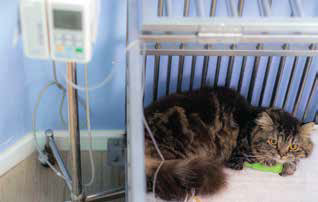While pneumonia is not common in cats, it can be devastating. If undetected for long enough, cats can end up hospitalized, in critical condition, and may even succumb to this respiratory disease.
Diagnosing the cause of respiratory distress in cats can be challenging, says Daniel Fletcher, PhD, DVM, an associate professor of emergency and critical care at Cornell University’s College of Veterinary Medicine. Heart failure and asthma are more common causes of breathing problems, but still, seeing your veterinarian at the first sign of respiratory difficulty is critical.
Symptoms of cats with pneumonia vary widely, but may include any or all of these symptoms:
- Cyanosis (bluish tint to mucous membranes)
- Cough
- Increased respiratory rate/effort
- Fever
- Ocular/nasal discharge
- Inappetence
- Lethargy
- Sneezing (in some cases)
- Weakness
- Weight loss
There are two types of pneumonia that are most common: aspiration and infectious.
Aspiration pneumonia occurs when your cat accidentally inhales something he shouldn’t, such as a small particle he was snuffling, some hastily eaten food, or vomit. Aspiration pneumonias are considered secondary risks of some toxins such as petroleum distillates. Inhaled acidic stomach contents can be irritating to delicate lung tissues as well. Smoke inhalation can damage lung tissue and mimic pneumonia.
Infectious pneumonia is more common and can be caused by bacteria, viruses, protozoa, parasites, or fungi inhaled from the environment. In many cases, these infections can be transmitted from one infected cat to another.
Lungworms, including Aelurostrongylus abstrusus and Capillaria aerophile, can also infect cats, resulting in respiratory symptoms. Cats most often encounter these parasites when hunting and eating hosts such as birds, lizards, snakes, snails, and rodents.
Diagnosis
Your veterinarian will do a careful auscultation of your cat’s lungs and take a thorough history. He or she will look to rule out more common causes of respiratory symptoms, such as feline asthma. “Cats are notoriously challenging to diagnose when they have pulmonary disease,” says Dr. Fletcher. “The general belief is that true pneumonia is pretty rare in cats. Things like asthma or cardiogenic pulmonary edema are much more common.”
- Diagnostic tests may include:
- Radiographs to evaluate the lungs
- Echocardiography to rule out heart disease
- Bronchial wash to retrieve cells to culture for a possible bacterial or fungal infection
- Heartworm test, as feline heartworm disease can negatively impact the lungs as well as the heart
- Fecal sample to rule out respiratory parasites such as lungworms
Treatment
While waiting for the cause to be determined, an initial treatment plan for suspected pneumonia will often consist of oxygen therapy, stabilization with intravenous fluids as needed, and broad-spectrum antibiotic therapy.
Once the cause is identified, treatment may change. For example, if the cause is determined to be a fungus or virus, appropriate drugs will be chosen to address these organisms.
Treatment for bacterial pneumonia generally starts with 10 to 14 days of antibiotics, but may extend to four to six weeks. Fungal pneumonias almost always require long-term treatment.
Medications such as albuterol (a bronchodilator) may be administered to open the airways. A steam vaporizer, such as those used for babies, or leaving your cat in the steamy bathroom while you shower, can help ease breathing. In most cases, cough suppressants are not required, as it is often better for your cat to cough up any debris in her airways.
Coupage, or percussion therapy, is a type of physical therapy that can help to loosen up debris in your cat’s airways that she can then, hopefully, cough up. This involves rapid taps on the chest wall. (If warranted, your veterinarian or veterinarian technician will teach you.)
Cats who have more serious illness will need to be hospitalized. Care might include oxygen therapy and a nebulizer to get medications deep into respiratory tissues. Medications may be switched to intravenous versions as opposed to oral, and placement of a feeding tube may be necessary for cats that will not eat on their own.
COVID-19 Connection
Cats are susceptible to SARS-Cov-2 infection and may show signs of COVID-19, although asymptomatic feline infections by SARS-CoV-2 virus are believed to be common. While human-to-cat spread has been shown to occur, no cases of cat-to-human spread of SARS-CoV-2 have been documented. If you are infected with SARS-CoV-2, isolate yourself from your cat if possible, and follow precautions while caring for your cat. Either have someone else do the care or wear a mask and wash your hands before handling your cat or her food, bowls, etc. Cats can share COVID-19 infections with other cats, but generally shed virus for a short period of time. Isolating your cats from any cat with signs of respiratory illness is always a good plan, especially until an appropriate diagnosis is made.




